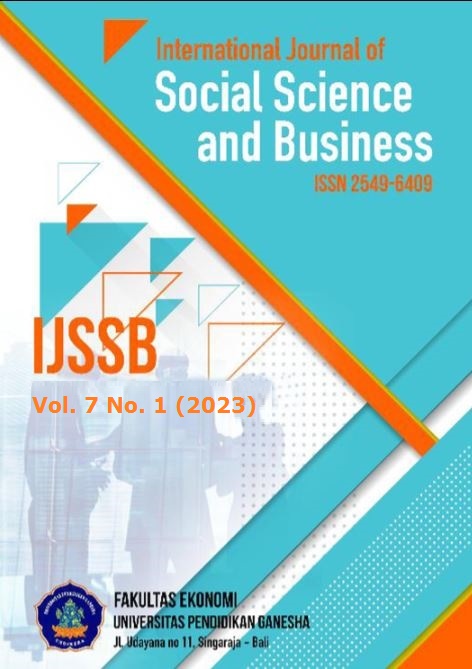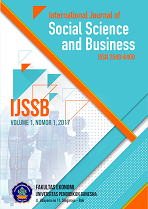The Influence of Auditor Opinion, Company Size, External Pressure on Fraud Financial Reporting with Industrial Conditions as Intervening Variables
DOI:
https://doi.org/10.23887/ijssb.v7i1.57651Keywords:
Auditor Opinion, Company Size, External Pressure on Fraud Financial Reporting, Industrial ConditionsAbstract
All manufacturing companies are competing to give the impression that people will not choose similar alternative products other than the company itself, so the company must have a strategy and characteristics that make the company increasingly known to the wider community. This study aims to analyze the influence of auditor opinion, company size, and external pressure on fraudulent financial reporting, by considering industry conditions as a mediating variable in manufacturing companies listed on the Indonesia Stock Exchange during the 2017-2021 period. The study population was 25 companies and the study sample consisted of 22 companies, with targeted non-probability sampling techniques. The results showed that auditors' opinions negatively affected fraudulent financial reporting, while company size negatively impacted fraudulent financial reporting. Meanwhile, external pressures have had a positive impact on fraudulent financial reporting. In addition, industry conditions can mediate the relationship between auditors' judgments and fraudulent financial reporting. However, the current state of the industry shows no link between company size and fraudulent financial reporting. The implications of this study emphasize the importance of proper internal supervision and control by companies to prevent and overcome the risk of financial reporting fraud, as well as the importance of strict and credible auditor supervision, and more careful attention to industry conditions that affect the level of financial reporting fraud.
References
Bellavance, F., Landry, S., & Schiehll, E. (2013). Procedural justice in managerial performance evaluation: Effects of subjectivity, relationship quality, and voice opportunity. The British Accounting Review, 45(3), 149–166. https://doi.org/10.1016/j.bar.2013.06.013. DOI: https://doi.org/10.1016/j.bar.2013.06.013
Blankespoor, E., Linsmeier, T. J., Petroni, K. R., & Shakespeare, C. (2013). Fair value accounting for financial instruments: Does it improve the association between bank leverage and credit risk? The Accounting Review, 88(4), 1143–1177. https://doi.org/10.2308/accr-50419. DOI: https://doi.org/10.2308/accr-50419
Brazel, J. F., Jones, K. L., Thayer, J., & Warne, R. C. (2015). Understanding investor perceptions of financial statement fraud and their use of red flags: Evidence from the field. Review of Accounting Studies, 20, 1373–1406. https://doi.org/10.1007/s11142-015-9326-y. DOI: https://doi.org/10.1007/s11142-015-9326-y
Dimitrijevic, D., Milovanovic, V., & Stancic, V. (2015). The role of a company’s internal control system in fraud prevention. Financial Internet Quarterly, 11(3), 34–44. https://doi.org/10.1515/fiqf-2016-0117. DOI: https://doi.org/10.1515/fiqf-2016-0117
Drempetic, S., Klein, C., & Zwergel, B. (2020). The influence of firm size on the ESG score: Corporate sustainability ratings under review. Journal of Business Ethics, 167, 333–360. https://doi.org/10.1007/s10551-019-04164-1. DOI: https://doi.org/10.1007/s10551-019-04164-1
Dyduch, J., & Krasodomska, J. (2017). Determinants of corporate social responsibility disclosure: An empirical study of Polish listed companies. Sustainability, 9(11), 1934. https://doi.org/10.3390/su9111934. DOI: https://doi.org/10.3390/su9111934
Edgley, C. (2014). A genealogy of accounting materiality. Critical Perspectives on Accounting, 25(3), 255–271. https://doi.org/10.1016/j.cpa.2013.06.001. DOI: https://doi.org/10.1016/j.cpa.2013.06.001
Fridson, M. S., & Alvarez, F. (2022). Financial statement analysis: a practitioner’s guide. John Wiley & Sons. DOI: https://doi.org/10.1002/9781119457176
Galantika, F. I., & Siswantaya, I. G. (2016). Analisis Perbedaan Earnings Response Coefficient (ERC) Sebelum dan Setelah Adopsi IFRS Pada Perusahaan yang Tercatat Dalam Bursa Efek Indonesia. Modus, 28(1), 39–56. https://doi.org/10.24002/modus.v28i1.664. DOI: https://doi.org/10.24002/modus.v28i1.664
Garanina, T., & Dumay, J. (2017). Forward-looking intellectual capital disclosure in IPOs: implications for intellectual capital and integrated reporting. Journal of Intellectual Capital, 18(1), 128–148. https://doi.org/10.1108/JIC-05-2016-0054. DOI: https://doi.org/10.1108/JIC-05-2016-0054
Gimbar, C., Hansen, B., & Ozlanski, M. E. (2016). The effects of critical audit matter paragraphs and accounting standard precision on auditor liability. The Accounting Review, 91(6), 1629–1646. https://doi.org/10.2308/accr-51382. DOI: https://doi.org/10.2308/accr-51382
Habib, A. (2013). A meta‐analysis of the determinants of modified audit opinion decisions. Managerial Auditing Journal, 28(3), 184–216. https://doi.org/10.1108/02686901311304349. DOI: https://doi.org/10.1108/02686901311304349
Hapsari, A. N., Putri, N. K., & Arofah, T. (2016). The influence of profitability, solvency, and auditor’s opinion to audit report lag at coal mining companies. Binus Business Review, 7(2), 197–201. https://doi.org/10.21512/bbr.v7i2.1685. DOI: https://doi.org/10.21512/bbr.v7i2.1685
Hermawan, S., Rahayu, D., Biduri, S., Rahayu, R. A., & Salisa, N. A. N. (2021). Determining Audit Quality in the Accounting Profession with Audit Ethics as a Moderating Variable. Indonesian Journal of Sustainability Accounting and Management, 5(1), 11–22. https://doi.org/10.28992/ijsam.v5i1.138. DOI: https://doi.org/10.28992/ijsam.v5i1.138
Khusnah, H., & Jannah, R. (2021). Dampak Self Efficacy, Moral Intention Dan Budaya Etis Organisasi Terhadap Whistleblowing Intention. Jurnal Akademi Akuntansi, 4(2), 221–228. https://doi.org/10.22219/jaa.v4i2.15385. DOI: https://doi.org/10.22219/jaa.v4i2.15385
Lennox, C., Lisowsky, P., & Pittman, J. (2013). Tax aggressiveness and accounting fraud. Journal of Accounting Research, 51(4), 739–778. https://doi.org/10.1111/joar.12002. DOI: https://doi.org/10.1111/joar.12002
Lev, B. (2018). The deteriorating usefulness of financial report information and how to reverse it. Accounting and Business Research, 48(5), 465–493. https://doi.org/10.1080/00014788.2018.1470138. DOI: https://doi.org/10.1080/00014788.2018.1470138
Mazkiyani, N., & Handoyo, S. (2017). Audit report lag of listed companies in Indonesia stock exchange. Jurnal Aplikasi Bisnis, 17(1), 77–95. https://doi.org/10.20885/jabis.vol17.iss1.art5. DOI: https://doi.org/10.20885/jabis.vol17.iss1.art5
Nukala, V. B., & Prasada Rao, S. S. (2021). Role of debt-to-equity ratio in project investment valuation, assessing risk and return in capital markets. Future Business Journal, 7(1), 13. https://doi.org/10.1186/s43093-021-00058-9. DOI: https://doi.org/10.1186/s43093-021-00058-9
Omar, N., Johari, Z. A., & Smith, M. (2017). Predicting fraudulent financial reporting using artificial neural network. Journal of Financial Crime, 24(2), 362–387. https://doi.org/10.1108/JFC-11-2015-0061. DOI: https://doi.org/10.1108/JFC-11-2015-0061
Pattiasina, V., Noch, M. Y., Surijadi, H., Amin, M., & Tamaela, E. Y. (2021). The relationship of auditor competence and independence on audit quality: An assessment of auditor ethics moderation and professional commitment. Indonesia Accounting Journal, 3(1), 14–26. https://doi.org/10.32400/iaj.31289. DOI: https://doi.org/10.32400/iaj.31289
Pinto, I., Morais, A. I., & Quick, R. (2020). The impact of the precision of accounting standards on the expanded auditor’s report in the European Union. Journal of International Accounting, Auditing and Taxation, 40. https://doi.org/10.1016/j.intaccaudtax.2020.100333. DOI: https://doi.org/10.1016/j.intaccaudtax.2020.100333
Prasmaulida, S. (2016). Financial statement fraud detection using perspective of fraud triangle adopted by SAS No. 99. Asia Pacific Fraud Journal, 1(2), 317–335. https://doi.org/10.21532/apfj.001.16.01.02.24. DOI: https://doi.org/10.21532/apfj.001.16.01.02.24
Purnamawati, I. G. A. (2018). Individual Perception of Ethical Behavior and Whistleblowing on Fraud Detection through Self-Efficacy. Jurnal Keuangan Dan Perbankan, 22(2), 362–372. https://doi.org/10.26905/jkdp.v22i2.1991. DOI: https://doi.org/10.26905/jkdp.v22i2.1991
Purnamawati, I. G. A., & Adnyani, N. K. S. (2019). The Government Auditor Professionalism Determinant. AKRUAL: Jurnal Akuntansi, 10(2), 105–118. https://doi.org/10.26740/jaj.v10n2.p105-118. DOI: https://doi.org/10.26740/jaj.v10n2.p105-118
Rahmi, F., & Sovia, A. (2017). Dampak sistem pengendalian internal, prilaku tidak etis, dan moralitas manajemen terhadap kecenderungan kecurangan akuntansi pada perusahaan developer di Pekanbaru. Jurnal Al-Iqtishad, 13(1), 48–66. https://doi.org/10.24014/jiq.v13i1.4388. DOI: https://doi.org/10.24014/jiq.v13i1.4388
Raiborn, C., Butler, J. B., Martin, K., & Pizzini, M. (2017). The internal audit function: A prerequisite for Good Governance. Journal of Corporate Accounting & Finance, 28(2), 10–21. https://doi.org/10.1002/jcaf.22246. DOI: https://doi.org/10.1002/jcaf.22246
Roychowdhury, S., Shroff, N., & Verdi, R. S. (2019). The effects of financial reporting and disclosure on corporate investment: A review. Journal of Accounting and Economics, 68(2–3), 101246. https://doi.org/10.1016/j.jacceco.2019.101246. DOI: https://doi.org/10.1016/j.jacceco.2019.101246
Saputra, D. (2022). Analysis of Accounting Implementation of Village Owned Business Entities (Bumdes) Kuantan Singingi Regency. Bilancia: Jurnal Ilmiah Akuntansi, 6(1), 13–21. https://doi.org/10.35145/bilancia.v6i1.1749. DOI: https://doi.org/10.35145/bilancia.v6i1.1749
Siswati, A. (2021). Dampak Pandemi Covid-19 pada Kinerja Keuangan (Studi kasus pada Perusahaan Teknologi yang Listing di BEI). Jibaku: Jurnal Ilmiah Bisnis, Manajemen Dan Akuntansi, 1(2), 63–73. https://doi.org/10.35473/.v1i2.1043.
Werastuti, D. N. S. (2013). Pengaruh auditor client tenure, debt default, reputasi auditor, ukuran klien dan kondisi keuangan terhadap kualitas audit melalui opini audit going concern. Vokasi: Jurnal Riset Akuntansi, 2(1). https://doi.org/10.23887/vjra.v2i1.1066.
Downloads
Published
How to Cite
Issue
Section
License
Copyright (c) 2022 I Kadek Pebri Artana, I Putu Gede Diatmika

This work is licensed under a Creative Commons Attribution-ShareAlike 4.0 International License.











